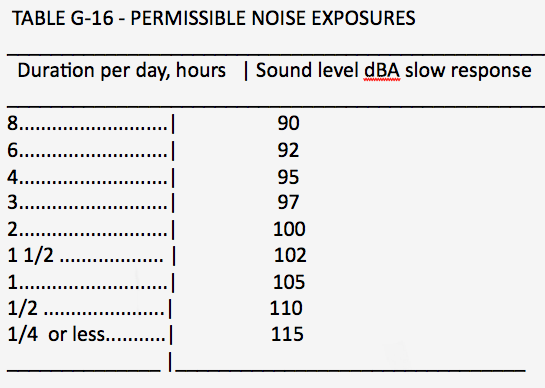Machinery Safety Information
OSHA Safety Regulations for Industrial Machines and Equipment
OSHA Regulations for Noise
Overview
OSHA sets legal limits on noise exposure in the workplace. These limits are based on a worker's time weighted average over an 8 hour day.With noise, OSHA's permissible exposure limit (PEL) is 90 dBA for all workers for an 8 hour day.
OSHA 1910.95(a) Protection against the effects of noise exposure shall be provided when the sound levels exceed those shown in Table G-16 when measured on the A scale of a standard sound level meter at slow response.
How to Calculate
When the daily noise exposure is composed of two or more periods of noise exposure of different levels, their combined effect should be considered, rather than the individual effect of each.If the sum of the following fractions:
C(1)/T(1) + C(2)/T(2) + C(n)/T(n)
exceeds unity, then, the mixed exposure should be considered to exceed the limit value.
Cn indicates the total time of exposure at a specified noise level. Tn indicates the total time of exposure permitted at that level.
Example:
At 105 dB, an exposure of 0.75 hours, plus At 100 dB, an exposure of 1.25 hours
(0.75/2.0) + (1.25/1.0) = 1.38
Hearing Conservation Program
In 1981, OSHA implemented new requirements to protect all workers in general industry for employers to implement a Hearing Conservation Program where workers are exposed to a time weighted average noise level of 85 dBA or higher over an 8 hour work shift.OSHA's Hearing Conservation Programs requires employers to:
measure noise levels, provide free annual hearing exams and free hearing protection, provide training, and conduct evaluations of the adequacy of the hearing protectors in use.
Training & Seminars
Safety Training
Advanced, high-level training Customized to your machines On-site at your facility Personalized to your needs Taught by a machine safety expert
 The most useful links, and the most helpful info for those using machinery and automated equipment.
The most useful links, and the most helpful info for those using machinery and automated equipment. There is a wealth of information within this site...
Useful Links
OSHA App: An iPhone app with all OSHA Regulations.
Expert Witness: An Expert in Machines, Manufacturing, and Automated Equipment.







